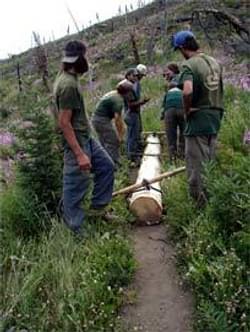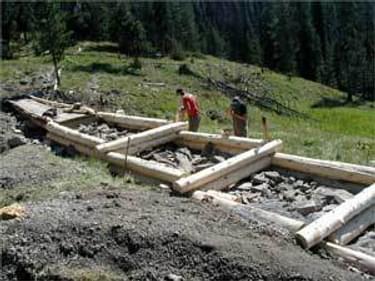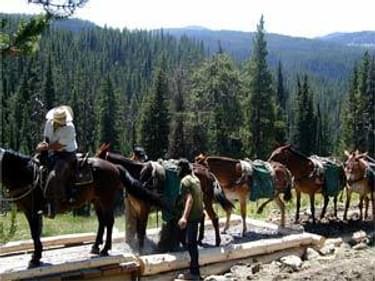
Maintenance and Rehabilitation
Teton Wilderness Maintenance and Rehabilitation Projects - Wyoming

In designated Wilderness work must use only traditional tools
Rick Taylor and his crew perform wilderness tail work utilizing only traditional tools.
The quality of work that has been done on these projects by Rick Taylor and his crew is of an incredibly high standard given that the Wilderness Act of 1964 and forest Service policy directs trail work within wilderness areas to be performed utilizing only traditional tools (traditional tools include cross cut saws, hand tools, horses and mules).
The projects have replaced structures that were badly deteriorated and unsafe and also provided environmental rehabilitation to areas that had been severely damaged as a result of previous trail use.
Specific projects which earned this award:
- Teton Wilderness Drainage Structure and Bridge Replacement, Repair and Maintenance, FY 2002 and 2003 -- The purpose of these projects was to replace, repair and perform maintenance on existing puncheons, bridges and other drainage structures on trails located in the Teton Wilderness that had deteriorated to the point where they posed a safety hazard to stock and to wilderness visitors.
- Teton Wilderness/Yellowstone Meadows Turnpike and Drainage Work, FY 2003 -- The purpose of this project was to turnpike sections of trail that travels through Yellowstone Meadows in the Teton Wilderness where bog problems have created safety issues and caused environmental damage.
- Westside Teton Wilderness Trail Relocation, Realignment, Clearing and Drainage Work in 1988 Burn Area, FY 2003 -- The purpose of this project was to maintain and enhance access to trails located in the west side of the Teton Wilderness by re establishing existing neglected trail corridors through realignment of steep sections of trail, relocation of trails when feasible away from creek beds, clearing trails of yearly heavy downfall that is the result of fire scarred dead standing trees falling across trails from the massive 1988 fires season in the Greater Yellowstone Area and installing draining structures to slow erosion of trail tread. Project components include the Whetstone, Pilgrim, West Pilgrim, Middle Pilgrim, Arizona, Sheffield, Wolverine and Coulter Creek Trails.
One of the unique aspects of one of these projects is that draft horses were purchased with some of the grant funds, as equipment, for the purpose of working on these trail projects in the Teton Wilderness. This need was identified as a result of reviewing historic practices of accomplishing heavy maintenance and heavy construction trail projects.
Specifically of concerns was the ability to move heavy materials safely. Pack stock have served as an extremely valuable tool for supporting district trail crews in their work on wilderness trails to pack in supplies and project materials.
More winners of this award
2023: Royal Palm Beach Pines Trails System
2021: Statewide Fourteeners Maintenance
2021: Neahkahnie Mountain to Manzanita Trail
2020: Cal-Ida connector Trail
2019: Stage Coach Trail Improvements - Vermont
2018: Horseshoe Bend Park Trail Restoration - New Jersey
2017: Alaka'i Swamp Trail - Hawaii
2016: Cochran Mill Park Trail - Georgia
2015: Ice Age Trail - Wisconsin
2014: Anthracite Outdoor Adventure Area - Pennsylvania
2014: Sawyer Trail Project/Russell Sage Wildlife Management Area - Louisiana
2013: Northern Erie Sno-Seekers Trail Grooming - New York
2012: Lombard Trail - Idaho
2011: Musselshell Trail System - Idaho
2010: Rampart Range OHV Development (Phase Three) - Colorado
2009: Kings Campground and Trailhead Project - California
2008: Storms' Crossing - Lewis and Clark Bicentennial Trail - South Dakota
2007: Cary Bayou Trail - Texas
2006: Wyoming State Trail Crew


